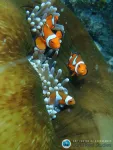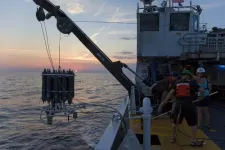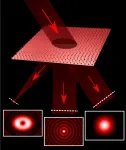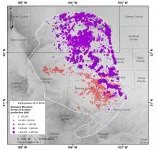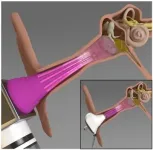(Press-News.org) A new study has found baby coral reef fishes can outpace all other baby fishes in the ocean.
Lead author Adam Downie is a PhD candidate at the ARC Centre of Excellence for Coral Reef Studies at James Cook University (Coral CoE at JCU).
Mr Downie said when considering aquatic athletes, young coral reef fishes shine: they are some of the fastest babies, swimming around 15-40 body lengths per second.
As a comparison, herring babies swim up to two body lengths per second, and the fastest human in the water, Olympic gold medalist Michael Phelps, can only swim 1.4 body lengths per second.
"We found the swimming performance in baby fishes relates to whether they ultimately associate with a reef or not," Mr Downie said.
"When they're a baby searching for a new reef to call home, a reef fish has to navigate the open ocean and its currents. To be successful at this they need a higher swimming capacity than other non-reef fishes."
"We think that, over evolutionary time, habitat association shaped the swimming performance in the early life stages of these marine fishes," said co-author Dr Peter Cowman, also from Coral CoE at JCU and Senior Curator of Biosystematics from Queensland Museum's Project DIG.
"In our study, we compared more than 200 marine fish species across their 150 million years of shared ancestry. We found baby fishes that settle onto a reef later in life, whether tropical or temperate, have evolved to grow larger muscles and swim faster than their non-reef relatives," Dr Cowman said.
The reef fish babies develop these muscles as well as their organs very quickly--all signs of great athletes. Other fishes--such as the herring, which remains in the open ocean for its whole life--don't have these attributes.
"These tiny creatures aren't just passive particles floating around in the ocean," said co-author Associate Professor Jodie Rummer, also from Coral CoE and the College of Science and Engineering at JCU. "They are finely tuned athletes."
"Swimming machinery forms early in a fish's life--and some just do it bigger, faster and better than others."
In another recent study, Mr Downie also found the health of the reef that baby reef fishes choose to call home could affect their athletic performance. Settling on degraded coral reefs may require extra energy for these young fishes, which could then compromise their growth, swimming and other vital activities.
"While reef fishes may be exceptional swimmers in early life, the condition of their home can have huge impacts on their performance--and likely their ability to develop into healthy adults," Mr Downie said.
Coral reefs worldwide are degrading due to climate change, pollution, boat traffic, sediment run-off and coastal development.
"As the global damage to coral reefs persists, future populations of reef fishes are at risk," Dr Rummer said.
"Compromising the health of baby fishes compromises the health of adult populations and therefore entire marine ecosystems," she said.
"There are around 17,000 known marine fish species," Mr Downie said. "They are an important part of any functioning marine ecosystem--not to mention crucial for fisheries, which support nearly half of the world's human population."
"Our findings show how important it is to urgently reduce the human impact on these fragile species and ecosystems," he said.
"Healthy reefs mean healthy fish and a healthy planet."
INFORMATION:
PAPERS
Downie A, Leis J, Cowman P, McCormick M, Rummer J. (2021). 'The influence of habitat association on swimming performance in marine teleost fish larvae'. Fish and Fisheries. DOI: 10.1111/faf.12580
Downie A, Phelps C, Jones R, Rummer J, Chivers D, Ferrari M, McCormick M. (2021). 'Exposure to degraded coral habitat depresses oxygen uptake rate during exercise of a juvenile reef fish'. Coral Reefs. DOI: 10.1007/s00338-021-02113-x
CONTACTS
Adam Downie (Townsville, AEST)
P: +61 (0) 403 587 050
E: adam.downie@my.jcu.edu.au
Jodie Rummer (Townsville, AEST)
P: +61 (0) 439 166 171
E: jodie.rummer@jcu.edu.au
Pete Cowman (Townsville, AEST)
P: +61 (0)490 231 223
E: peter.cowman@qm.qld.gov.au
FOR FURTHER INFORMATION
Melissa Lyne/ Coral CoE (Sydney, AEST)
P: +61 (0)415 514 328
E: melissa.lyne@jcu.edu.au
The year 2020 was a period of economic hardship and significant change in a wide range of sectors for most countries. A team of authors from HSE University has explored how Russia will recover from this crisis and which industries will be affected by the economic recovery. Their study was published in the journal Voprosy ekonomiki.
Last year, the global economy experienced a crisis due to the coronavirus pandemic, with output falling by 3.5% compared to 2019. Russia's decline from the coronavirus measures was more moderate than in many developed countries (industrial ...
Almost all of the nitrogen that fertilizes life in the open ocean of the Gulf of Mexico is carried into the gulf from shallower coastal areas, researchers from Florida State University found.
The work, published in Nature Communications, is crucial to understanding the food web of that ecosystem, which is a spawning ground for several commercially valuable species of fish, including the Atlantic bluefin tuna, which was a focus of the research.
"The open-ocean Gulf of Mexico is important for a lot of reasons," said Michael Stukel, an associate professor in the Department of Earth, ...
LAWRENCE -- Despite facing cultural and political pushback, the evidence remains clear: Face masks made a difference in Kansas.
"These had a huge effect in counties that had a mask mandate," said Donna Ginther, the Roy A. Roberts Distinguished Professor of Economics and director of the Institute for Policy & Social Research at the University of Kansas. "Our research found that masks reduced cases, hospitalizations and deaths in counties that adopted them by around 60% across the board."
Ginther's article "Association of Mask Mandates and COVID-19 ...
Washington, DC--Location, location, location--when it comes to the placement of wind turbines, the old real estate adage applies, according to new research published in Proceedings of the National Academy of Sciences by Carnegie's Enrico Antonini and Ken Caldeira.
Turbines convert the wind's kinetic energy into electrical energy as they turn. However, the very act of installing turbines affects our ability to harness the wind's power. As a turbine engages with the wind, it affects it. One turbine's extraction of energy from the wind influences the ability of its neighbors to do the same.
"Wind is never going to 'run dry' as an energy resource, but our ability to harvest it isn't infinitely scalable either," Antonini explained. "When wind turbines ...
The ability to precisely control the various properties of laser light is critical to much of the technology that we use today, from commercial virtual reality (VR) headsets to microscopic imaging for biomedical research. Many of today's laser systems rely on separate, rotating components to control the wavelength, shape and power of a laser beam, making these devices bulky and difficult to maintain.
Now, researchers at the Harvard John A. Paulson School of Engineering and Applied Sciences have developed a single metasurface that can effectively tune the different properties of laser light, ...
In the context of recent debate over the FDA's approval of aducanumab, it's refreshing to learn about a model of Alzheimer's neurodegeneration that doesn't start with the pathogenic proteins amyloid or Tau.
A new paper in Alzheimer's & Dementia from Emory neuroscientist Shan Ping Yu and colleagues focuses on an unusual member of the family of NMDA receptors, signaling molecules that are critical for learning and memory. Their findings contain leads for additional research on Alzheimer's, including drugs that are already FDA-approved that could be used preventively, and genes ...
Deployable structures -- objects that transition from a compact state to an expanded one -- are used everywhere from backyards to Mars. But as anyone who has ever struggled to open an uncooperative folding chair knows, transforming two-dimensional forms into three-dimensional structures is sometimes a challenge.
Now, researchers from the Harvard John A. Paulson School of Engineering and Applied Sciences (SEAS) and the Harvard Graduate School of Design have developed a deployable system that is light, compact, inexpensive, easy to manufacture, and, most importantly, easy to deploy. By harnessing the mechanical instabilities in curved beams, the system can transform objects into elaborate and customizable 3D configurations on a range of scales, from large-scale furniture to small medical ...
Boulder, Colo., USA: Subsurface carbon sequestration--storing carbon in
rocks deep underground--offers a partial solution for removing carbon from
the atmosphere. Used alongside emissions reductions, geologic carbon
sequestration could help mitigate anthropogenic climate change. But like
other underground operations, it comes with risks--including earthquakes.
Geophysicists are still working to understand what can trigger
human-induced earthquakes, which have been documented since the 1960s. A
new study, published in Geology on Thursday, explores why part of
a heavily produced oilfield in the U.S. has ...
Middle ear infections, also known as otitis media, affect more than 80% of the children in the U.S. In a new study, researchers have designed a miniaturized 3D-printed device to inactivate Pseudomonas aeruginosa, a common bacterium that causes the infection.
The device--a microplasma jet array--generates plasma, which is composed of charged particles and reactive molecules that have been previously shown to inactivate various pathogens. "This is the first time anyone has tried treating middle ear infections using plasma technology," said Jungeun Won, a graduate student in the Boppart lab. "Usually, the treatment involves using ...
HUNTINGTON, W.Va. - According to researchers at Marshall University, a maternal diet rich in Omega-3 fatty acids protects from breast cancer development in offspring. In a new study recently published by Frontiers in Cell and Developmental Biology, researchers noted a significant difference in mice from mothers that were fed a diet rich in canola oil, compared with mothers fed a diet rich in corn oil. A maternal Omega 3-rich diet affected genome-wide epigenetic landscape changes in offspring and potentially modulated gene expression patterns.
Dr. Ata Abbas, a former postdoctoral research fellow in Marshall's Department of Biological Sciences, headed a research team under the leadership ...
